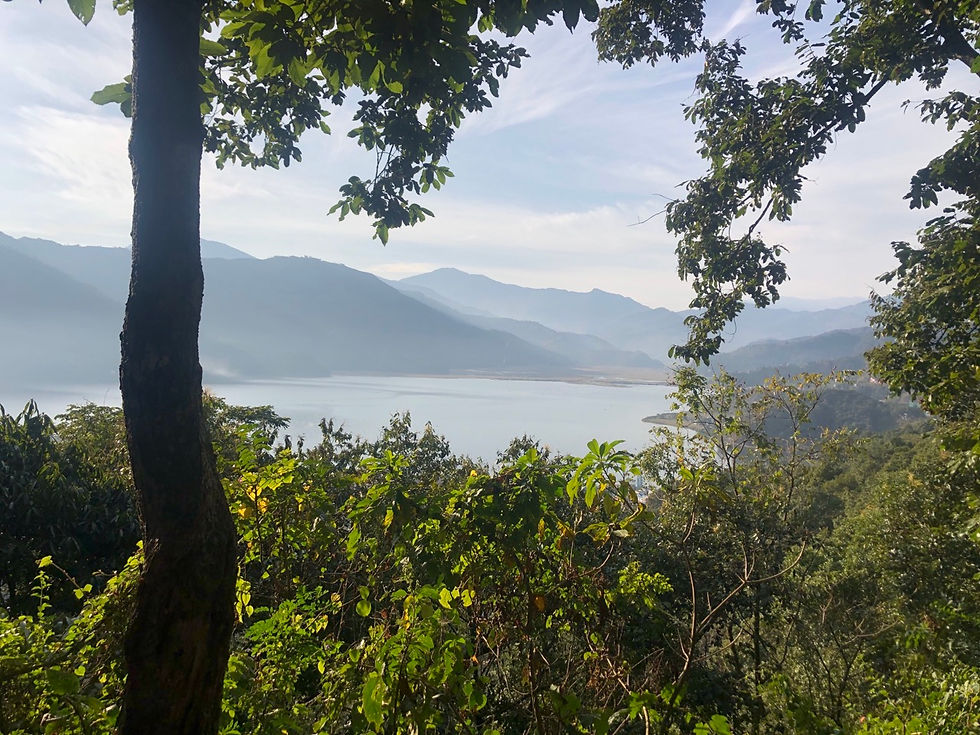Him A-Layin' 'Round 2
- krolesh
- Feb 3, 2024
- 4 min read
I spent a couple of days wandering about this amazing city.
The streets of the Old City are full of temples and shrines, fascinating buildings, shops and houses.

Footpath shrines






The shops aren’t open yet. It’s late Saturday morning.

Katesimbhu Stupa, a beautiful Buddhist stupa down a tiny laneway

The whole square was infested with pigeons. It reminded me of that Albert Hitchcock film, Birds. But luckily they didn’t peck my eyes out, or kill me by constantly pecking at my temples like jackhammers while I screamed in agony and everyone else ran away.



Stunning wooden work of art


Traditional architecture.
Many of the older buildings in this city were built during the rule of the Malla dynasty, in the 1300s. So Kathmandu is another fully fledged medieval city.


Traditional Nepali clobber. I was given a hat like this by Subash, in Lumle.

There was a lot of action in Asan Tole, a market square south of Thamel. Local Newari women were making bara, lentilflour pancakes with egg, and these amazingly shaped sweets, yomari, stuffed with a semi-sweet semi-bitter tamarind paste. The pancakes were the bomb, the filling of the yomari wasn’t really my thing. Another one for the acquired taste list.





Asan Bazaar laneway


Temples and shrines galore. Basically on every street.


Kathmandu and surrounding districts was devastated by a killer earthquake back in April 2015. About 9,000 people were killed, and at least 30,000 more seriously injured. Over 600,000 structures in Kathmandu and nearby towns and villages were either damaged or totally destroyed.
Some of the destroyed buildings were priceless ancient treasures.
With numbers like that you can just imagine the scale of the disaster. The city is yet to fully recover, with parts of the city still lying in semi-rubble, and some infrastructure, like some roads and footpaths, remaining unrepaired. The quake completely destroyed some of the most densely populated suburbs of the city.
The earthquake wasn’t unexpected. The Himalayas is one of the most seismically active zones in the world. There were huge quakes in Kathmandu in 1934 and 1988 as well. And there’s more to come, no doubt.

Rubble



Kathmandu Durbar Square
Durbar (Royal Palace) Square in Kathmandu is one of three durbar squares in the Kathmandu Valley. The others are in Patan and Bhaktapur. All are UNESCO World Heritage sites, and for good reason.
Although construction of the square began way back in the 3rd Century, many of the temples were constructed in the 1500s by the ruling Malla kings. The buildings are magnificent, with beautiful facades in traditional Newari architecture. The Newar people were the original inhabitants of the Kathmandu Valley.

As you approach Durbar Square, the narrow choked laneways of the city open out into spacious wide boulevardes.

There’s important and historic temples all over the shop.


Kaal Bhairav, a fierce warrior form of Shiva. This statue was sculpted in the 5th or 6th Century.



The Taleji Bhawani Temple, completed in 1564. The Goddess Taleji Bhawani was the royal deity of the Malla kings.




Gaddi Baithak, a neo-classical building, which is brand new, relatively (built in the 1900s).

The Jagganath Temple. The column, erected by one of the Malla kings, fell during the earthquake, but has been repaired.



Mahadev Temple
Yeah, a number of buildings were damaged or completely destroyed during the earthquake. But a remarkable number survived, considering what happened in some other parts of Kathmandu.

There’s repair work going on all over the place still.

Kumari
In Nepal, there’s an ancient tradition of worshipping a chosen virgin known as a Kumari, who is actually a physical manifestation of divine female energy, or shakti.
These girls are actually alive, they’re real girls.
And it is believed that they are real, living goddesses.
Kumaris are selected from the Shakya clan of the Newari Buddhist community. It’s a rigorous selection procedure, and the girl has to be pretty much perfect in every way, whatever that means, including:
perfect health, with no history of illness, unblemished skin, black hair, gorgeous expressive eyes, a sonorous voice, long slender arms, delicate and soft hands and feet, straight hair curled towards the right side, no bad body smells, and must not have shed any blood, yada yada….
So they get ‘em nice and young.
The current Kumari of Kathmandu, the most important Kumari in the country, is Trishna Shakya, and she was installed at the ripe old age of five. There are nine other young girls, living Kumaris, in Nepal.
As soon as they become Kumaris their lives change irreversibly. They leave their friends and family and live in a Kumari palace with strangers. They have public audiences all the time, and partake in countless rites and rituals every day, including major public festivals. Their feet are never allowed to touch the ground, so they get carried around on palanquins wherever they go.
They aren’t allowed to show any emotion, but just stay poker-faced the whole time, especially during audiences. If they frown, tremble, cry or show any other emotion, it’s believed their audience will have major tragedies in their lives, including imminent death.
Thankfully, as soon as they start menstruating it’s believed that the goddess deity has left their body, and that the girls have returned to human form. So they’re then theoretically free of Royal duties, and can go back to normal life, which, unfortunately, is actually completely un-normal.
Ex-Kumaris are partly feared and partly revered. If you marry one of them the widely held superstition is that you will die within six months. (They probably leave that small detail out on their dating apps).

A living goddess. She looks sad to me.
Go to Part 3


Comments